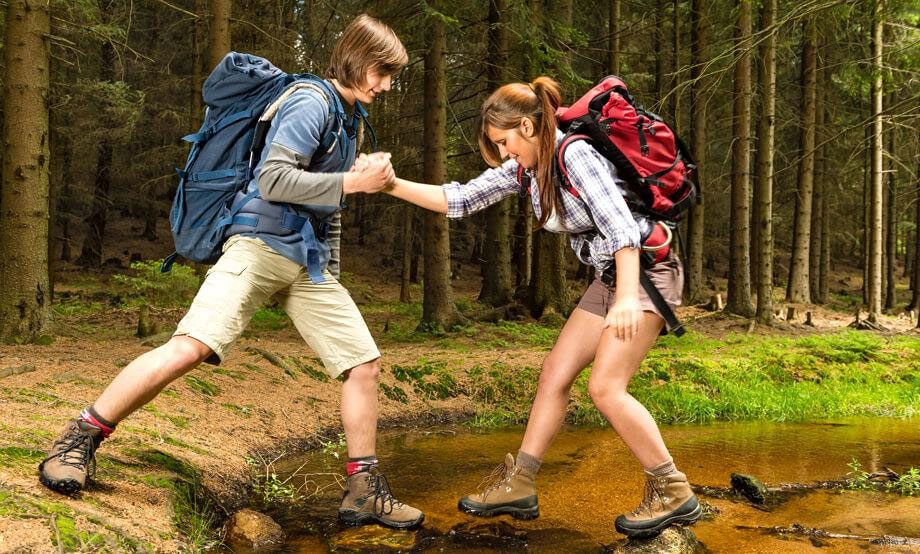It isn’t hard to figure out why so many people love hiking - it provides access to the country's most beautiful, natural spots, it’s a fun way to stay healthy, and it’s affordable.
While hiking in the spring does provide an extraordinary view of nature, it also introduces unique risks. Spring means that hibernating animals and insects are waking up, snow is melting and rivers are running. This month Paul Low, an instructor with AIP and a former North Coast Search and Rescue member, takes us through some safety tips to keep in mind during springtime expeditions.
Spring conditions
Snow. Rain. Mud. These are all common hazards of spring hiking as well. But the good news is that each week these conditions get better. Snow melts. Rainy skies give way to sunny ones. Trail crews remove downed trees and fix muddy spots on the trail. If you are properly prepared for spring conditions, spring hiking can be some of the most enjoyable.
There will still be snow on most trails. If you would like to push through snowy areas, you should be prepared with traction devices for your hiking boots or snowshoes. As tempting as it may be to push through, you should also be willing to turn back if the snow is too deep or icy, the trail is unclear or the situation seems dangerous.
Make sure you wear appropriate clothing. When it comes to clothing, your choice or preference should meet two very important criteria: comfort and practicality. There are no fashion statements in the wilderness. Wear boots with ankle supports, dry socks and comfortable clothes. You’ll also want to pack extra clothes and think about layers.
The weather up on a mountain is often different then it is down at the trailhead. You could ascend up to a windy ridge, or get stuck in an unexpected downpour. Bring a rain poncho, gloves, and a toque just in case. Also try to avoid cotton and polyester materials, which absorb moisture. Opt instead for wool or polypropylene fabrics that will help keep you dry and comfortable while you hike.
Beware of wildlife
Remember that you are a guest and need to respect the animals who live there. When exploring, the goal is to avoid disrupting or surprising the local wildlife—especially a bear that has just woken up from a winter nap.
The most useful and easiest tactic a person can employ is to simply make noise. In most cases, if the wildlife can hear you, they will make every attempt to avoid you. Travel in groups of two or more and sing, tell stories or carry a bell to let bears know you are in the area. Your voice is your best defence. It doesn’t matter what is said, just say it loudly!
Plan your trip. Make sure that you are only out in the woods during daylight hours. Find an available hiking trail or picnic site, and stay on the path. It’s important to make sure you know where you are going, and when you’re going to be there before you head out.
Pay attention to your environment. If you are in an area with lots of trees, wet moss or rushing streams, you will want to make even more noise. These natural elements will absorb sounds and human scents, and make it easier for you to surprise a wild animal.
If you encounter an animal, stay calm. Do not approach the animal. Speak in a calm voice to let the animal figure out what you are. Back away slowly and don’t make eye contact. It’s also important to remember that in the spring, bears will have their cubs with them and are very protective. Give the bears extra space and do not ever get in between a mother bear and her cubs.
To learn more about animal safety, take AIP’s Bear Awareness Training Course.
Bugs and insects are awake too!
Spring is also the time of year when the smallest creatures that call the forest home will start making an appearance. Here are some things to keep in mind to avoid bug bites and stings when you are out on an adventure.
Use bug spray. There are many varieties of different bug sprays and repellents that you can pick up at your local drug store that will do the trick. You can use any brand or kind you prefer, but they should contain at least one of the following ingredients: Lemon, Eucalyptus, Picaridin or Deet.
Avoid other sprays. Simple products that we normally use, such as hairspray, perfume, cologne, or aftershave are bug magnets. Avoid any product that has a fragrance or sweet smell when you are out on the trail.
Be prepared for ticks. Ticks are notoriously hungry in the springtime as well. If you find a tick on you, they will try to migrate to an area that is covered in hair to hide. If you find a tick that has started to dig into your skin, do not twist it out. Simply grab the tick’s head with tweezers and pull the tick straight out. As soon as possible, wash the area with soap and water and apply an antibiotic ointment. If you develop a red rash or experience flu-like symptoms after a tick bite, if could mean lyme disease. Seek medical attention immediately.
With these items in mind, you and your family will be ready to safely hike and explore the trails, woods, and mountains. Get out and enjoy nature this spring!
For more safe hiking tips, keep an eye on the AIP blog next month for the second part of this series.

